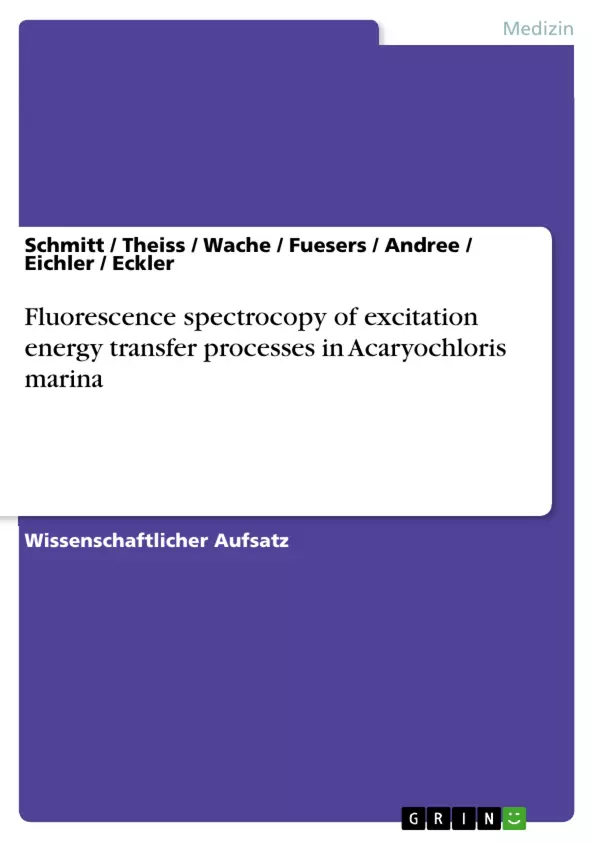Time- and wavelength-resolved fluorescence spectroscopy is an appropriate tool for quantitative and non-invasive investigations of living cells. Short measurement times with low excitation light intensities are necessary to observe variations of the fluorescence due to changes in the metabolism of the sensitive biological organisms.
With new techniques the fluorescence dynamics can be monitored simultaneously in a broad spectrum during a very short measurement time. That provides information about the spectral differences of the fluorescence dynamics which can vary in correlation with the metabolic changes.
The interaction of the photosynthetic subunits and especially the mechanisms regulating the energy transfer are presently interesting and open fields in photosynthesis research.
The phototrophic cyanobacterium Acaryochloris marina contains membrane extrinsic PBP antenna complexes and mainly Chl d containing membrane intrinsic core antenna complexes which absorb light and transfer excitation energy to the reaction center.
The results of our studies suggest a fast excitation energy transfer kinetics of 20-30 ps along the PBP antenna of A.marina followed by a transfer with a time constant of about 60 ps to Chl d.
Very often cells or cell fragments are kept at low temperature to decelerate ageing processes. Living cells of A. marina which were stored at 0°C for some time showed a reduced excitation energy transfer from the PBP to the Chl d antenna, which partially recovered when the sample had been kept at 25 °C for a short time.
The reduction of the excitation energy transfer might be caused by a mechanism that decouples the PBP antenna under cold stress conditions avoiding photo damage of the reaction center of PS II.
Inhaltsverzeichnis
- 1. Introduction
- 2. Materials and methods
- 2.1 Algal culture
- 2.2 Excitation sources
- 2.3 Fluorometer system
- 2.4 Data Analysis
- 3. Results
- 4. Decoupling of the PBPs under cold stress
- 5. Excited state populations according to a model of rate equations
- 6. Discussion
Zielsetzung und Themenschwerpunkte
Diese Studie untersucht die metabolischen Veränderungen in lebenden Zellen des Chl d-haltigen Cyanobakteriums Acaryochloris marina mithilfe von zeit- und wellenlängenkorreliertem Einzelphotonenzählen. Die Untersuchung zielt darauf ab, die Dynamik der Fluoreszenz und den Energietransfer in den Photosynthese-Antennenkomplexen von A. marina zu verstehen und die Auswirkungen von Kältebedingungen auf diese Prozesse zu analysieren.
- Fluoreszenzdynamik und Energietransfer in Acaryochloris marina
- Einfluss von Kältebedingungen auf den Energietransfer
- Metabolische Anpassungen von A. marina auf Kältestress
- Rolle der Phycobiliproteine (PBPs) in der Photosynthese von A. marina
- Anwendung zeit- und wellenlängenkorreliertem Einzelphotonenzählens für die Untersuchung lebender Zellen
Zusammenfassung der Kapitel
Die Einleitung (Kapitel 1) führt in die Thematik der Studie ein und erläutert die Bedeutung von Acaryochloris marina als Modellorganismus für die Photosyntheseforschung. Kapitel 2 beschreibt die verwendeten Materialien und Methoden, darunter die Kultivierung der Algen, die Anregungsquellen, das Fluorometer-System und die Datenanalyse.
Kapitel 3 präsentiert die Ergebnisse der Studie, die aufzeigen, dass der Energietransfer in den Photosynthese-Antennenkomplexen von A. marina eine Kinetik von 20-30 ps hat.
Kapitel 4 untersucht die Auswirkungen von Kältebedingungen auf den Energietransfer und zeigt, dass unter Kältebedingungen ein reduzierter Energietransfer von den PBP-Antennen zu Chl d beobachtet wird.
Kapitel 5 befasst sich mit der Beschreibung der angeregten Zustände der Antennenkomplexe anhand eines Modells von Raten-Gleichungen.
Schlüsselwörter
Die Studie befasst sich mit den Schlüsselbegriffen Acaryochloris marina, Fluoreszenzdynamik, Spektroskopie, Phycobiliproteine, Chlorophyll d, Fluoreszenzlebensdauer, Energietransfer, Phycocyanin, Allophycocyanin, Zellmetabolismus, Photosyntheseforschung, Biotechnologie, Biomedizin und Lebenswissenschaften.
- Quote paper
- Schmitt (Author), Theiss (Author), Wache (Author), Fuesers (Author), Andree (Author), Eichler (Author), Eckler (Author), 2007, Fluorescence spectrocopy of excitation energy transfer processes in Acaryochloris marina, Munich, GRIN Verlag, https://www.hausarbeiten.de/document/159775


